

Free online palaeography resources. Brodie Waddell Palaeography – the art of reading old handwriting – is a very specialized skill that will not be of use to 99.9 percent of the population.

However, if you want to explore original sources produced before c.1750 for a dissertation, genealogy or local history, it may be essential. The problem is that the script below was a perfectly normal way to write in the seventeenth century. A Gateway to Greek Manuscripts. Gereedschapskist Neerlandistiek. Latin numbers, words and phrases used for dates. Books before print. Toolkit Palaeography // Western European History at Notre Dame // Blog Network // University of Notre Dame. Palaeography (or Paleography) is the study and analysis of handwriting in order to read old texts with accuracy and fluency.
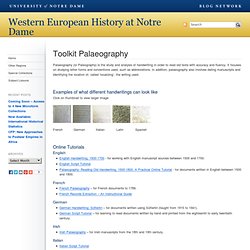
It focuses on studying letter forms and conventions used, such as abbreviations. In addition, palaeography also involves dating manuscripts and identifying the location of, called ‘localizing’, the writing used. Examples of what different handwritings can look like Click on thumbnail to view larger image French German Italian Latin Spanish Online Tutorials English French German German Handwriting: Sütterlin – for documents written using Sütterlin (taught from 1915 to 1941).German Script Tutorial – for learning to read documents written by hand and printed from the eighteenth to early twentieth century. Irish Irish Palaeography – for Irish manuscripts from the 18th and 19th century. Italian. Grotefend. Fraktur Chart. Medieval Calendar Calculator. Enigma. Middle English Dictionary. Latin Dictionary and Grammar Aid. Type in the form of the word that you would expect to find in a dictionary or a truncated form of the word (e.g., stem only).
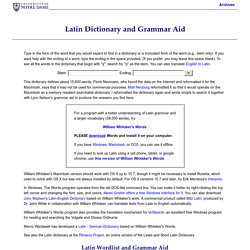
If you want help with the ending of a word, type the ending in the space provided. (If you prefer, you may leave this space blank). To see all the words in the dictionary that begin with "q", search for "q" as the stem. You can also translate English to Latin. This dictionary defines about 15,600 words. William Whitaker's Macintosh version should work with OS X up to 10.7, though it might be necessary to install Rosetta, which used to come with OS X but was not always installed by default. In Windows, The Words program operates from the old DOS-like command line. William Whitaker's Words program also provides the translation mechanism for VulSearch, an excellent free Windows program for reading and searching the Vulgate and Glossa Ordinaria. Wörterbücher und Indices (Mediaevum.de) Dictionary of Medieval Latin from British Sources.
Two assumptions frequently made about Latin in the medieval period are that it was simply the language of the Christian church and that the standard of Latin use was universally poor and not worthy of interest.
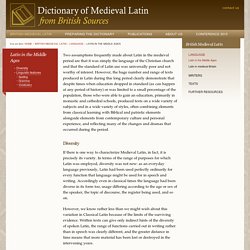
However, the huge number and range of texts produced in Latin during this long period clearly demonstrate that despite times when education dropped in standard (as can happen at any period of history) or was limited to a small percentage of the population, those who were able to gain an education, primarily in monastic and cathedral schools, produced texts on a wide variety of subjects and in a wide variety of styles, often combining elements from classical learning with Biblical and patristic elements alongside elements from contemporary culture and personal experience, and reflecting many of the changes and dramas that occurred during the period.
Diversity If there is one way to characterize Medieval Latin, in fact, it is precisely its variety. Linguistic features Spelling Grammar. Cappelli-cappelli.html. Medieval Latin Paleography. Abbreviationes™ Online: The first Web database of medieval Latin abbreviations. Home | Solutions | Contents | Features | Web Browsers | Web Servers | Users | Editions | Order Now “Take a foreign language, write it in an unfamiliar script, abbreviating every third word, and you have the compound puzzle that is the medieval Latin manuscript.”¹ Solving this puzzle is both an art and a science.
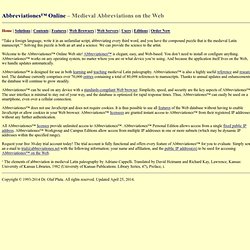
We can provide the science to the artist. Welcome to the Abbreviationes™ Online Web site! Abbreviationes™ is elegant, easy, and Web-based. You don’t need to install or configure anything. Abbreviationes™ is designed for use in both learning and teaching medieval Latin paleography. Abbreviationes™ can be used on any device with a standards-compliant Web browser. Site Map. 47cappelli.pdf. Codicologische eenheden - opzet voor een terminologie. Paleografiecursus. Paleografie (Grieks: παλαιός - 'oud', γράφειν - 'schrijven') is een hulpwetenschap van de geschiedschrijving.
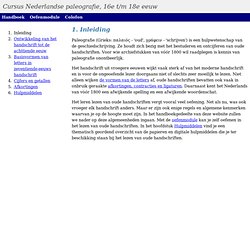
Ze houdt zich bezig met het bestuderen en ontcijferen van oude handschriften. Voor wie archiefstukken van vóór 1800 wil raadplegen is kennis van paleografie onontbeerlijk. Latin Palaeography. Editions and Editing. The Art of Editing ⇒ Editions and Editing This part of Central offers an introduction to the skills needed to work with critical editions and medieval manuscripts.
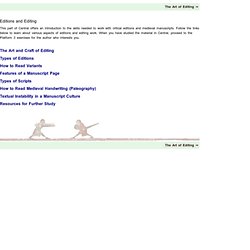
Follow the links below to learn about various aspects of editions and editing work. When you have studied the material in Central, proceed to the Platform 3 exercises for the author who interests you. Album interactif de paléographie médiévale / Interactive Album of Mediaeval Palaeography. Introduction La paléographie médiévale est une science à part entière, qui nécessite un long apprentissage.
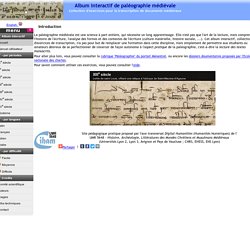
Elle n'est pas que l'art de la lecture, mais comprend aussi l'histoire de l'écriture, l'analyse des formes et des contextes de l'écriture (culture matérielle, histoire sociale, ...). Cet album interactif, collection d'exercices de transcription, n'a pas pour but de remplacer une formation dans cette discipline, mais simplement de permettre aux étudiants ou amateurs désireux de se perfectionner de s'exercer de façon autonome à l'aspect pratique de la paléographie, c'est-à-dire la lecture des textes manuscrits.
Pour savoir comment utiliser ces exercices, vous pouvez consulter l'aide. XVe siècleLes célèbres empreintes de pattes laissées par un chat sur un registre de correspondance commerciale à Dubrovnik: découvrez le texte qui se cache sous les empreintes! XIIIe siècleExtrait du Secretum secretorum.